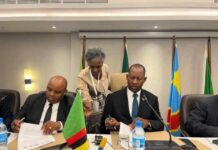Zambia’s overuse of the world’s biggest man
made reservoir to generate electricity has depleted its water
levels, according to Guy Scott, a former vice president who led
the country for three months until January this year. His
comments contradict government assertions that drought is to
blame for the country’s worst-ever power crisis.
Lake Kariba straddles Zambia’s border with Zimbabwe,
generating hydropower for both southern African countries. Poor
oversight has allowed both nations to compete in over-exploiting
this source of electricity, Scott said, driving water levels
down to 29 percent of capacity this month from 70 percent a year
ago.
“What we have now is a weak regulator sitting between two
puppies drinking milk from the same saucer,” Scott, who is still
a member of parliament, told lawmakers in the capital Lusaka,
according to a transcript posted on Parliament’s website
Wednesday. “If one does not lick fast enough, it will not get as
much as the other one.”
Kariba’s low water levels have compelled both countries to
cut electricity generation and have led to rotating power cuts
that last as long as 14 hours a day. Zambia’s energy shortage
has also led to mine suspensions in Africa’s second-largest
producer of copper and thousands of planned job cuts. It’s also
contributed to this year’s 47 percent depreciation of the
kwacha, the world’s worst-performing currency, against the
dollar.
Zambia aggravated the situation at Kariba by continuously
running a 360-megawatt hydropower expansion, designed only to
operate for 3.5 hours a day during peak demand, said Scott, who
became acting President when Michael Sata died in October. Scott
officially opened the plant, which increased generating capacity
on the Zambian side of the dam by 50 percent, in August last
year.
“I am the one who turned it on and I said, ‘Is there enough
water for this?’ It was a huge contraption and everybody said
‘yes,’” he told lawmakers Sept. 23. “When I went to sleep at the
hotel down from the Kariba Dam, all night and morning the water
gushed past. Once they had their toy, they pushed the button,
turned it on and left it, and down went the water.”
Meager water levels at Kariba and at the Kafue Gorge power
station, which account for nearly 90 percent of the country’s
generation capacity, mean Zambia could only supply an average of
half of normal peak power demand in September, Mines and Energy
Minister Christopher Yaluma said this month. Total installed
generation capacity from all power plants is 2,300 megawatts,
according to Zesco, the state-owned power supplier.
‘Sharing Difficult’
While data from Zesco show that water inflows from the
Zambezi river were lower than previous years, the company has
also used more water than it is allocated, figures in a Sept. 5
statement from the utility indicate.
The Zambezi River Authority, which regulates Kariba and is
run by the two countries’ governments, allocated Zesco water to
generate 1,944 gigawatt hours of electricity from April through
September, according to the statement. Instead, it produced
2,971 gigawatt hours, 46 percent more than it was supposed to.
Zambia uses hydroelectricity for more than 95 percent of
its power needs. Kariba North Bank power station had fewer than
70 days from Sept. 5 before it exhausted its water allocation,
Zesco said in a statement that day.
Zambia’s power shortages and the effects of climate change
are “inextricably inseparable,” President Edgar Lungu, who won
the January elections to replace Sata, said in a speech to the
United Nations General Assembly in New York Tuesday.
Munyaradzi Munodawafa, chief executive officer of the
Zambezi River Authority, didn’t answer two calls to his mobile
phone seeking comment.
“It is very difficult to share hydroelectric facilities
with other countries,” Scott said. “It is a well-known problem
throughout the world and I think it needs to be addressed.
Bloomberg-Mathew Hill

 JOIN DRIVERN TAXI AS PARTNER DRIVER TODAY!
JOIN DRIVERN TAXI AS PARTNER DRIVER TODAY!












That’s y I like linsay this man makes my day
Now I get the point…nowander?!!